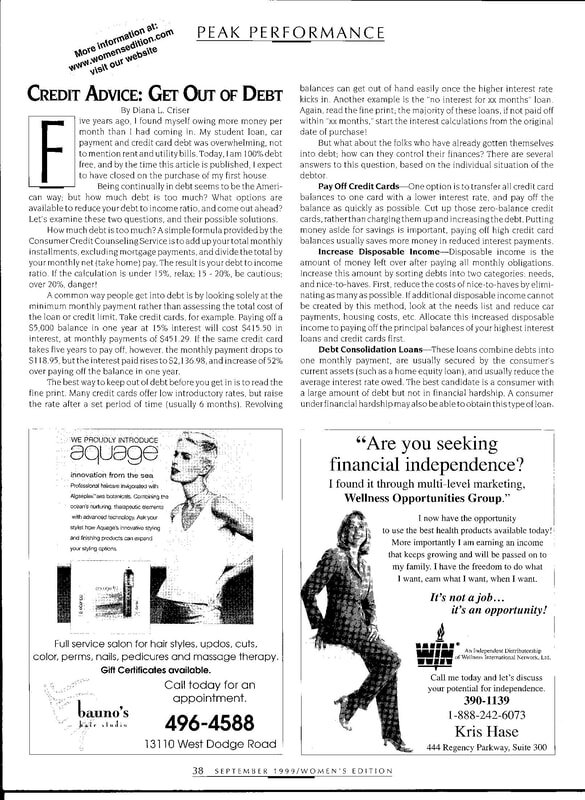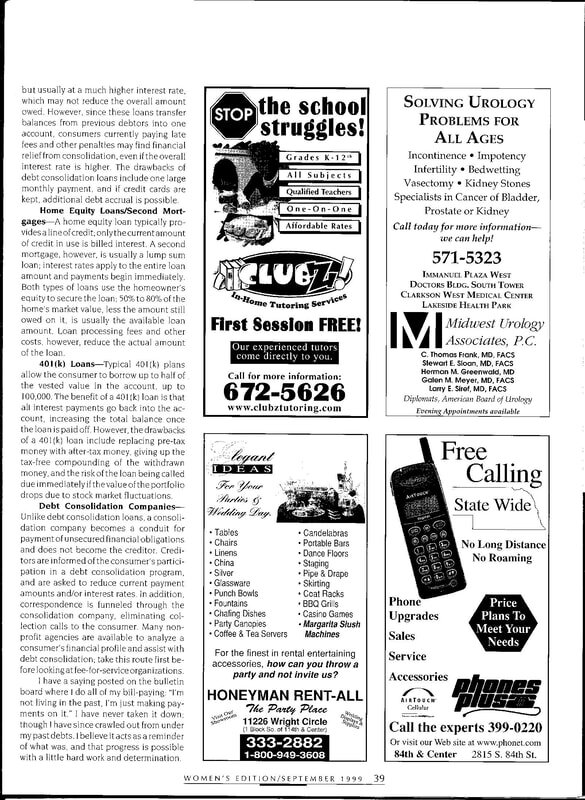Peak Performance - September 1999
CREDIT ADVICE: GET OUT OF DEBT
By Diana L. Criser

ive years ago, I found myself owning more money per month than I had coming in. My student loan, car payment and credit card debt was overwhelming, not to mention rent and utility bills. Today, I am 100% debt free, and by the time this article is published, i expect to have closed on the purchase of my first house.
Being continually in debt seems to be the American way, but how much debt is too much? What options are available to reduce your debt to income ratio, and come out ahead? Let's examine these two questions, and their possible solutions.
How much debt is too much? A simple formula provided by the Consumer Credit Counseling Service is to add up your total monthly installments, excluding mortgage payments, and divide the total by your monthly net (take home) pay. The result is your debt to income ratio. If the calculation is under 15%, relax; 15020%, be cautious; over 20%, danger!
A common way people get into debt is by looking solely at the minimum monthly payment rather than assessing the total cost of the loan or credit limit. Take credit cards, for example. Paying off a $5,000 balance in one year at 15% interest will cost $415.50 in interest, at monthly payments of $451.29. If the same credit card takes five years to pay off, however, the monthly payment drops to $118.95, but the interest paid rises to $2,136.98, an increase of 52% over paying off the balance in one year.
The best way to keep out of debt before you get in is to read the fine print. Many credit cards offer low introductory rates, but raise the rate after a set period of time (usually 6 months). Revolving balances can get out of hand easily once the higher interest rate kicks in. Another example is the "no interest for XX months" loan. Again, read the fine print; the majority of these loans, if not paid off within "XX months", start the interest calculations from the original date of purchase!
But what about the folks who have already gotten themselves into debt; how can they control their finances? There are several answers to this question, based on the individual situation of the debtor.
Pay Off Credit Cards - One option is to transfer all credit card balances to one card with a lower interest rate, and pay off the balance as quickly as possible. Cut up those zero-balance credit cards, rather than charging them up and increasing the debt. Putting money aside for savings is important, but paying off high credit card balances usually saves more money in reduced interest payments.
Increase Disposable Income - Disposable income is the amount of money left over after paying all monthly obligations. Increase this amount by sorting debts into two categories: needs, and nice-to-haves. First, reduce the cost of nice-to-haves by eliminating as many as possible. If additional disposable income cannot be created by this method, look at the needs list and reduce car payments, housing costs, etc. Allocate this increased disposable income to paying off the principal balances of your highest interest loans and credit cards first.
Debt Consolidation Loans - These loans combine debts into one monthly payment, are usually secured by the consumer's current assets (such as a home equity loan), and usually reduce the overall interest rate owed. The best candidate is a consumer with a large amount of debt but not in financial hardship. A consumer under financial hardship may also be able to obtain this type of loan relief from consolidation, even if the overall interest rate is higher. The drawbacks of debt consolidation loans include one larger monthly payment, and if credit cards are kept, additional debt accrual is possible.
Home Equity Loans/Second Mortgages - A home equity loan typically provides a line of credit; only the current amount of credit in use is billed interest. A second mortgage, however, is usually a lump sum loan; interest rates apply to the entire loan amount and payments begin immediately. Both types of loans use the homeowner's equity to secure the loan; 50-80% of the home's market value, less the amount still owed on it, is usually the available loan amount. Loan processing fees and other costs, however, reduce the actual amount of the loan.
401(k) Loans - Typical 401(k) plans allow the consumer to borrow up to half of the vested value of the account, up to $100,000. The benefit of a 401(k) loan is that all interest payments go back into the account, increasing the total balance once the loan is paid off. However, the drawbacks to a 401(k) loan include replacing pre-tax money with after-tax money, giving up the tax-free compounding of the withdrawn money, and the risk of the loan being called due immediately if the value of the portfolio drops due to stock market fluctuations.
Debt Consolidation Companies - Unlike debt consolidation loans, a consolidation company becomes a conduit for payment of unsecured financial obligations and does not become the creditor. Creditors are informed of the consumer's participation in a debt consolidation program, and are asked to reduce current payment amounts and/or interest rates. In addition, correspondence is funneled through the consolidation company, eliminating collection calls to the consumer. Many non-profit agencies are available to analyze a consumer's financial profile and assist with debt consolidation; take this route first before looking at fee-for-service organizations.
I have a saying posted on the bulletin board where I do all of my bill-paying: "I'm not living in the past, I'm just making payments on it." I have never taken it down, though I have since crawled out from under my past debts. I believe it acts as a reminder of what was, and that progress is possible with a little hard work and determination.
Being continually in debt seems to be the American way, but how much debt is too much? What options are available to reduce your debt to income ratio, and come out ahead? Let's examine these two questions, and their possible solutions.
How much debt is too much? A simple formula provided by the Consumer Credit Counseling Service is to add up your total monthly installments, excluding mortgage payments, and divide the total by your monthly net (take home) pay. The result is your debt to income ratio. If the calculation is under 15%, relax; 15020%, be cautious; over 20%, danger!
A common way people get into debt is by looking solely at the minimum monthly payment rather than assessing the total cost of the loan or credit limit. Take credit cards, for example. Paying off a $5,000 balance in one year at 15% interest will cost $415.50 in interest, at monthly payments of $451.29. If the same credit card takes five years to pay off, however, the monthly payment drops to $118.95, but the interest paid rises to $2,136.98, an increase of 52% over paying off the balance in one year.
The best way to keep out of debt before you get in is to read the fine print. Many credit cards offer low introductory rates, but raise the rate after a set period of time (usually 6 months). Revolving balances can get out of hand easily once the higher interest rate kicks in. Another example is the "no interest for XX months" loan. Again, read the fine print; the majority of these loans, if not paid off within "XX months", start the interest calculations from the original date of purchase!
But what about the folks who have already gotten themselves into debt; how can they control their finances? There are several answers to this question, based on the individual situation of the debtor.
Pay Off Credit Cards - One option is to transfer all credit card balances to one card with a lower interest rate, and pay off the balance as quickly as possible. Cut up those zero-balance credit cards, rather than charging them up and increasing the debt. Putting money aside for savings is important, but paying off high credit card balances usually saves more money in reduced interest payments.
Increase Disposable Income - Disposable income is the amount of money left over after paying all monthly obligations. Increase this amount by sorting debts into two categories: needs, and nice-to-haves. First, reduce the cost of nice-to-haves by eliminating as many as possible. If additional disposable income cannot be created by this method, look at the needs list and reduce car payments, housing costs, etc. Allocate this increased disposable income to paying off the principal balances of your highest interest loans and credit cards first.
Debt Consolidation Loans - These loans combine debts into one monthly payment, are usually secured by the consumer's current assets (such as a home equity loan), and usually reduce the overall interest rate owed. The best candidate is a consumer with a large amount of debt but not in financial hardship. A consumer under financial hardship may also be able to obtain this type of loan relief from consolidation, even if the overall interest rate is higher. The drawbacks of debt consolidation loans include one larger monthly payment, and if credit cards are kept, additional debt accrual is possible.
Home Equity Loans/Second Mortgages - A home equity loan typically provides a line of credit; only the current amount of credit in use is billed interest. A second mortgage, however, is usually a lump sum loan; interest rates apply to the entire loan amount and payments begin immediately. Both types of loans use the homeowner's equity to secure the loan; 50-80% of the home's market value, less the amount still owed on it, is usually the available loan amount. Loan processing fees and other costs, however, reduce the actual amount of the loan.
401(k) Loans - Typical 401(k) plans allow the consumer to borrow up to half of the vested value of the account, up to $100,000. The benefit of a 401(k) loan is that all interest payments go back into the account, increasing the total balance once the loan is paid off. However, the drawbacks to a 401(k) loan include replacing pre-tax money with after-tax money, giving up the tax-free compounding of the withdrawn money, and the risk of the loan being called due immediately if the value of the portfolio drops due to stock market fluctuations.
Debt Consolidation Companies - Unlike debt consolidation loans, a consolidation company becomes a conduit for payment of unsecured financial obligations and does not become the creditor. Creditors are informed of the consumer's participation in a debt consolidation program, and are asked to reduce current payment amounts and/or interest rates. In addition, correspondence is funneled through the consolidation company, eliminating collection calls to the consumer. Many non-profit agencies are available to analyze a consumer's financial profile and assist with debt consolidation; take this route first before looking at fee-for-service organizations.
I have a saying posted on the bulletin board where I do all of my bill-paying: "I'm not living in the past, I'm just making payments on it." I have never taken it down, though I have since crawled out from under my past debts. I believe it acts as a reminder of what was, and that progress is possible with a little hard work and determination.
DROP ME A LINE
Like what you see? Let's get in touch!
Diana Criser, CUA, CXA
User Experience Practitioner
Omaha, Nebraska
User Experience Practitioner
Omaha, Nebraska
402.598.4969


